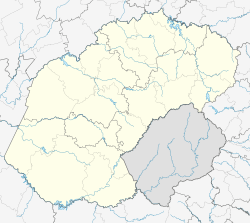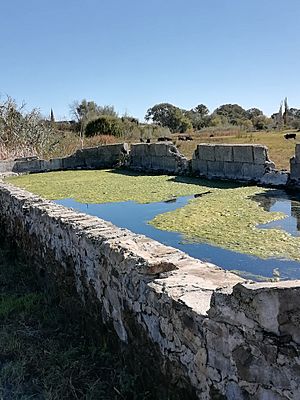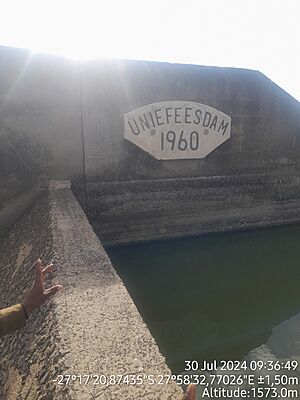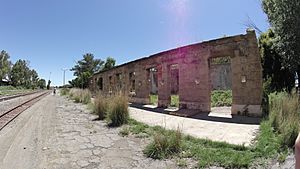Heilbron facts for kids
Heilbron is a town located in the Free State province of South Africa. It's an important center for farming, especially for cattle, dairy products, and crops like sorghum, sunflowers, and maize. The town also processes these farm products into things like snacks and animal feed.
Because Heilbron is quite close to the big city area of Gauteng (only about 60 km away), it has become a popular place for weekend visitors and city people looking for a peaceful break. Many tourists come to enjoy activities like horse riding, off-road cycling, fishing, and game drives. You can also learn about history here and enjoy affordable sports facilities. The area is also known for Game farming, where wild animals are raised, attracting many visitors.
Quick facts for kids
Heilbron
|
|
|---|---|
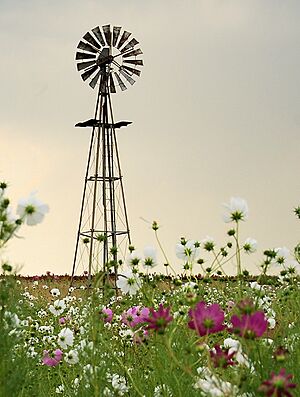 |
|
| Country | South Africa |
| Province | Free State |
| District | Fezile Dabi |
| Municipality | Ngwathe |
| Established | 1872 |
| Area | |
| • Total | 17.7 km2 (6.8 sq mi) |
| Elevation | 1,540 m (5,050 ft) |
| Population
(2011)
|
|
| • Total | 27,407 |
| • Density | 1,548/km2 (4,010/sq mi) |
| Racial makeup (2011) | |
| • Black African | 88.2% |
| • Coloured | 5.5% |
| • Indian/Asian | 0.3% |
| • White | 5.6% |
| • Other | 0.3% |
| First languages (2011) | |
| • Sotho | 74.9% |
| • Afrikaans | 12.2% |
| • Zulu | 7.2% |
| • Xhosa | 1.6% |
| • Other | 4.1% |
| Time zone | UTC+2 (SAST) |
| Postal code (street) |
9650
|
| PO box |
9650
|
| Area code | +27 (0) 58 |
| Website | http://www.heilbron.info/ |
Contents
History of Heilbron
Heilbron has a rich history, including important events and changes over time.
Early Battles and Founding
In 1836, a group of settlers called the Voortrekkers fought against the local Ndebele people, led by Chief Mzilikazi, at the Battle of Vegkop. This battle happened near where Heilbron is today. You can visit a monument and a museum at this historical site to learn more about the battle.
Heilbron was officially started in 1873. The town was built around a natural spring that never dries up. This is why it's called 'Heilbron', which means 'Spring of Bliss' in Afrikaans. A small stream flows from this spring through the town. Different groups of people have lived along this stream for hundreds of years.
Heilbron During the Anglo-Boer War
During the Anglo-Boer War, which lasted from 1899 to 1902, Heilbron played an important role. After the British took over Bloemfontein in March 1900, Heilbron became the temporary capital of the independent Boer Republic of the Orange Free State. However, the British soon occupied Heilbron too. The president then moved the capital to another town.
Many Boer fighters continued to resist the British. To try and stop them, the British destroyed Boer farms and built concentration camps. One of these camps was in Heilbron. These camps were meant to house Boer women, children, and workers who supported the fighters. Sadly, thousands of people died in these camps from hunger, sickness, and harsh conditions. Black people were also affected. Today, the Heilbron concentration camp site is a private school, and there's a monument in the town's cemetery to remember those who died.
Jewish Community and the Riemland Museum
In its early days, several Jewish citizens helped develop Heilbron. Because of their contributions, many streets in the town are named after important Jewish founders. The old synagogue (a Jewish place of worship) in Heilbron has been turned into a museum called the "Riemland Museum."
Places to Visit in Heilbron
Heilbron has several interesting places to explore, offering a glimpse into its past and natural beauty.
Heilbron Train Station
The railway line in Heilbron was first built in 1899. It connected to Wolwehoek and was later extended to other towns like Petrus Steyn and Lindley. The old train station building, made of sandstone, is now a provincial heritage site, meaning it's protected for its historical importance.
NG Church
The Dutch Reformed Church (NG Church) in Heilbron was established in 1874. Its beautiful sandstone building was officially opened in 1885. On the church grounds, there is a monument dedicated to the local citizens who died during the Anglo-Boer War.
Leeuwpoort of the Weilbachs Farms
During the Anglo-Boer War, Heilbron was briefly the capital of the Free State. One of the houses on the Leeuwpoort farm was built in 1894. This house was not burned down by the British, unlike many others, because a family with 12 children lived there. Even Winston Churchill, a famous British leader, visited the Leeuwpoort farm, which was used as a base by British officers during the war. These farms are now provincial heritage sites.
Mother and Child Memorial
This memorial remembers the 787 Boer women and children who died in the British concentration camp at Heilbron between 1899 and 1902 during the Anglo-Boer War. The large cemetery nearby serves as a powerful reminder of this sad time.
Corbelled Houses
Studies by Tim Maggs in 1976 found evidence of early Basotho settlements in the area. These unique "corbelled houses" were built between 1600 and 1800 AD. They are known as "Mohlongwa-fatshe" and have a special "V" shape, named after the nearby Vegkop battle site.
Vechtkop Battlefields, Monument and Museum
The Battle of Vegkop was a major conflict between the Matebele people of Mzilikazi and the Voortrekkers led by Hendrik Potgieter. It took place just outside Heilbron on October 16, 1836. About 6,000 Matebele warriors attacked the Voortrekkers' laager (a camp protected by a circle of wagons). In the battle, 430 Matebele and two Voortrekkers were killed. Today, you can visit the battlefields, a monument, and a museum to learn about this historical event.
Riemland Museum
The Riemland Museum is located in an old Jewish synagogue. This building itself tells a story about the Jewish community's influence on the town's history. The museum shares the history of early hunters in the Riemland area, as well as the first pioneers and settlers who came to live there.
Heilbron in Books
Heilbron has been mentioned in books, including Dr. Leonard Lotzof's autobiography called Spilt Milk.
Famous People from Heilbron
- Thandani Ntshumayelo, a South African football (soccer) player.
- Henning Klopper
- Sisi Mabe
- Peter Maltitz Anderson


